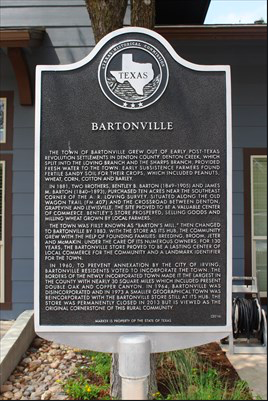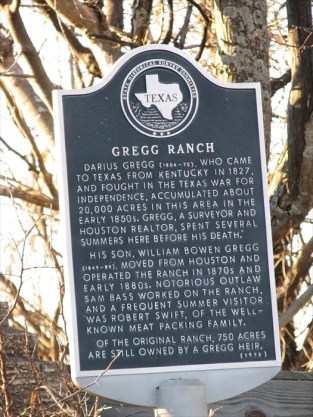
Bartonville Historical Marker, est. 2016.
Like many other towns in Texas, Bartonville got its start after the Texas Revolution during Texas’s early years of statehood. Originally, the land was inhabited by the Native American groups of the Comanches, Kiowas, Wichitas, and their subgroup of Kichais. The early Anglo settlers of the Bartonville area were enticed to the location by the promise of opportunity and lush land. The struggling Republic of Texas continued the empresario program that was established under Spanish and Mexican flags, to build the republic’s population. In 1841 the Texas Emigration and Land Company was awarded a vast amount of land. The land grant that made the Peters Colony served as the framework for all the settlements that eventually evolved into 26 counties, including Denton.
Bartonville had a plethora of resources at hand. Two branches of the Denton Creek – Loving Branch and Sharps Branch – provided fresh water to the early settlers of Bartonville. It was also situated in a thin forest belt of the Easter Cross Timbers which provided a ready-available source of timber to build with and fertile, sandy soil to plant their crops. Prior to the Civil War, these settlers were predominantly subsistence farmers, but the post-war arrival of the railroads expanded the economy of Denton County. With the arrival of the railroad, Bartonville was altered as crops could now be exported beyond the means of the region. In 1881 the red winter variety wheat was introduced to the county and became the new cash crop that established an important economic base for the settlers of Bartonville.

Bartonville Store, date unknown.
Bartonville was first known as “Barton’s Mills” due to it being one of the leading producers of wheat in the state, and the two brothers – James M. Barton and Bentley “B.B.” Ballard – who purchased significant amounts of land in the area to farm. The Bartonville Store was established in 1882 and became an iconic landmark of the town and served as the hub of the community. The petition for postmaster was awarded in 1886 and the Bartonville Post Office was attached to the store, with the store’s original owners serving as postmaster until 1905.
In the first half of the 20th-century, Bartonville remained rural while surrounding communities either grew into full-fledged cities or faded into history, keeping its identity intact. Its population grew steadily, and the landmark Bartonville Store held on during the Second World War and the Great Depression, only closing its doors in 2013 after 130 years of operation. The 2010 census listed 1,469 residents across its 5,152 acres. Today, the Bartonville Store has been revamped into a deli with a bar and grill to provide residents and visitors with the unique Texas experience.

Bartonville Town Hall

